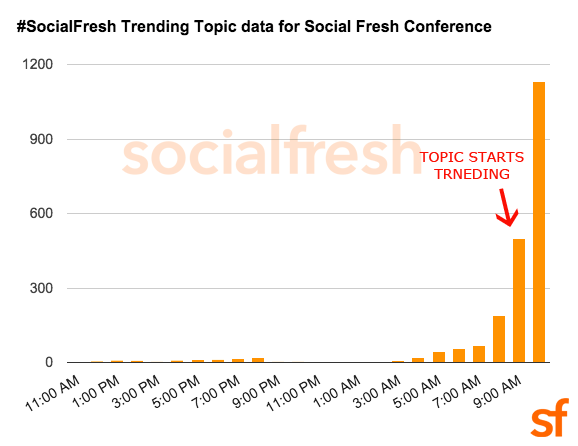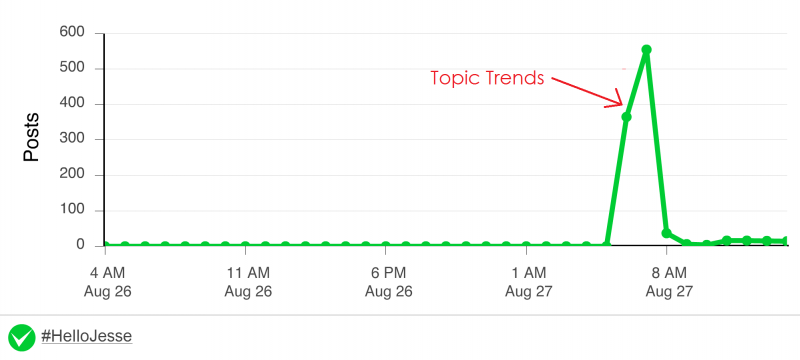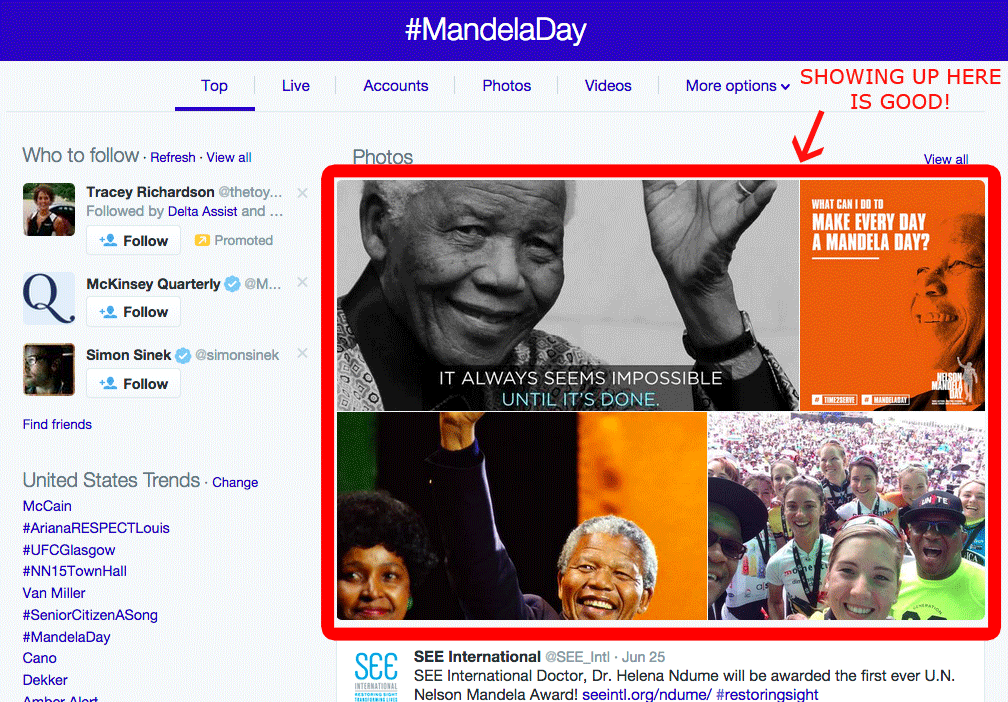For years now, every Social Fresh Conference trends No. 1 in the US. We always use #socialfresh, and it’s a great brand awareness opportunity every event. We’re building the curriculum for the upcoming conference—taking place this Sept. 23–25 in Tampa—and we thought the tactics we use to create a trending topic would be useful to share.
Trending topics are, increasingly, valuable to gain visibility with a huge audience. They’ve always been powerful, but Twitter has made them more and more prominent. In fact,according to a recent report, Twitter plans to give even more attention to trending topics, events and news.
Beyond just top of the funnel awareness for your business, generating and owning a trending topic can be incredibly useful for building community, follower growth and audience research.
Can Any Business Create a Trending Topic?
The following tips focus on creating a trending topic with your existing resources and not buying a trending topic, which is cost prohibitive for many.
You might think it’s easy for Social Fresh Conference or big brands to create trending topics. To an extent, having a built-in audience is a great first step—and we’ll review that—but it’s not the only way to help create a trending topic. Having a big audience does not guarantee your hashtag will trend. Our conference is intimate and limited to no more than 500 social marketers. So we definitely have a great audience, excited to engage with our hashtag. However, I’ve been involved with Twitter chats, webinars and happy hours from which we were able to generate trending topics, big to small.
How Many Tweets Are Needed to Trend?
There is no perfect example or precise number, but let’s break down what I know about our #socialfresh trending topic and at least one other example.
The #socialfresh hashtag always trends No. 1 in the US within the first few hours of the opening sessions of our conference. It typically stays in the top 10 for the rest of the conference and moves back into the No. 1 spot a few more times.
Here is a chart of what that looks like:

You’ll notice that our hashtag saw little use leading up to the morning of the conference, which is the first time we ask attendees to use it with a specific call to action. This most recent example shows a jump from around 150 Tweets to about 500 Tweets as the conference gets under way.
This specific timing is when we ask all our attendees to do something we call Fresh Networking. They break into groups, figure out a few answers to very specific questions (e.g., who traveled the farthest and who has been on Twitter the longest) and then Tweet their answers with the #socialfresh hashtag.
Social Fresh Conference goes on to generate thousands of Tweets, sometimes over 1,000 per hour, as our amazing speakers take the stage. But it usually only takes us a few hundred to get the trending topic started. Cision wrote a great article with three examples of the number of Tweets needed to trend. Two of the three examples generated thousands of Tweets for hours. But one example (see #HelloJesse below) only created a few hundred Tweets for two hours. It was for a Mexican pop band.

Yes, it’s easier if you have a lot of Tweets, but it’s very possible to create a trending topic with just a couple hundred people Tweeting multiple times each hour. There are a few crucial ingredients and tips that will help you do the same.
First, let’s review tactics to help you actually create the trend, and then let’s look at how to benefit from your trending topic.
1. Use Existing Audiences
As I mentioned, if you have a built-in audience, it really helps. A conference, happy hour, meetup, webinar or Twitter chat works. If you do not regularly host an event like this, consider it. The benefits for building community and meeting your stakeholders face to face are immense.
If you have a big email list or Instagram community or blog readership, engage those audiences. Give them a heads-up and a clear call to action. Make it easy for them to support your campaign.
When most people think of a trending topic, they think of the types of hashtags that Jimmy Fallon promotes on “The Tonight Show.” Jimmy asks his studio audience and, you know, a few million people watching at home to take their short and funny hashtag and run with it. Here’s an example called #WorstAdvice:
These types of crowd sourced and viral trending topics take massive audiences, a lot of paid promotion and maybe a little bit of luck. I won’t be focusing on these directions. You do not need these ingredients.
2. Use a Unique Hashtag
We use our brand name, #socialfresh. This can work for some, but don’t be afraid to pick something unbranded and even language that is more of a casual conversational style. I’ve heard experts recommend not using your brand name in the hashtag. I recommend using your best judgement. It works for us, but your mileage may vary. A great example of an unbranded hashtag is RadioShack’s #UNeedANewPhone hashtag from a few years ago. It was unbranded and very casual (true to the style of Twitter conversations, shortening You to U).
The best hashtags are usually new and never used before, or at least not used that often. In general, if it gets more than a few Tweets a day, I would consider something more original just to be safe. Twitter takes into account past topic activity.
For instance, we do not activate the #socialfresh hashtag outside of our conference, so it still works well for us. The conference is the only time we specifically ask people to Tweet out the #socialfresh hashtag. However, years ago, we used #sofresh as a hashtag—which was really fun—but we were competing with people Tweeting about taking a shower or their new outfit for the weekend.
3. Pick Your Timing
It’s been recommended to me by a few experts to try and avoid primetime TV hours in the US since those shows may be heavy competition for a trending topic. Even though it is still possible to create trending topics any time of day, I generally agree that shooting for less competitive time slots is a good strategy.
Avoiding large sporting events and entertainment events would also be something to consider for the same reason. I’ve seen success with Social Fresh in the morning and afternoon.
4. Give Precise Directions
The most common mistake I see is not giving your audience a reason to use the hashtag. There are a few ways to do this, but anything is better than simply saying, “Please Tweet out our hashtag; we want to trend.”
Make a Simple Ask
Simply ask for a very specific type of Tweet. At the beginning of a webinar, you can ask everyone to Tweet out their business name and what they do. At Social Fresh, we use the networking opportunity I mentioned above.
Give Examples
Give examples of what you’re looking for as well. When we asked attendees to Tweet welcome messages to our cohosts last year, I put a funny example up on the screen from my own account.
Give Incentives
We always make sure to incentivize the use of the #socialfresh hashtag at each conference. We might offer up door prizes, such as a Social Fresh T-shirt, or even give out a free VIP upgrade. Last year, we partnered with Omni Hotels and offered some very cool prizes. Omni gave away two free multi-night stays at their resorts and made very specific asks for photos, of both the conference and resorts. It was highly successful.
5. Involve Partners
Whether your event includes speakers, cohosts, sponsors or more, there are always partnerships you can include in your planning. Loop your stakeholders into the process about your plan for the hashtag and your goals for success.
If there are no obvious partners, reach out and find them, either through your online community, influencers, vendors or industry peers. Give them the knowledge and assets they need to help you expand the reach of your trending topic efforts.
6. Have a Plan
The most important step is to have a plan for why you want to create a trending topic and how you will take advantage of it. Also, be clear on what success looks like. This may seem like an obvious step, but planning for success is critical and often overlooked.
Decide if you want to build awareness, and define who you want to build awareness with. Maybe you want to grow your email list or let the press know about a new product. Maybe you want to educate existing customers. Choose your goal, and plan for that success.
7. Pick 1 Account to Focus On
A trending topic does very little if you have not planned great content. You’ll want to have content written out from at least one brand or personal account that you want to focus on. More than one account can benefit from the trending topic, but pick one to focus on.
For our conferences, we use our @socialfresh account as well as our staff personal accounts, but @socialfresh is the focus.
8. Create Entertaining Content
The content you create from your owned accounts should be a big investment. These are going to be your opportunities for accomplishing your goal, especially if the hashtag you are using is unbranded.
You want to create content that provides a specific call to action or sends your hashtag audience to a specific website. It’s equally important to have a large supply of funny and/or entertaining content that will get shared.

Entertaining content is more likely to include a photo, chart, illustration or quote and less likely to include a link.
9. Create Calls to Action
You’ve defined what success looks like, now create Tweets you can promote to help accomplish your goals.
You can promote these Tweets in two ways: 1) You can pay to promote a Tweet, so that it shows up at the top of the list of hashtagged Tweets—high visibility! 2) You can use your owned accounts and team/staff accounts to drive engagement with a specific Tweet via favoriting, Retweeting and replying. This can also push a Tweet to the top of the list of hashtagged Tweets.
I recommend the following course of action: Do both!
10. Track Your Success
Tools such as Sprout Social that provide social media monitoring are an important part of understanding your success.
You want to track two things: the Tweets and the conversions. Having a database of how many Tweets were sent out, when and by whom is very helpful, especially after you complete the campaign. You want to know what worked and what didn’t. Know how many times your links were clicked and whether the trending topic actually helped you build awareness or generate email leads.
Always take the time to determine your metrics before the campaign launches.
Trending topics are not out of your reach and can be great short-term campaigns for your social media marketing efforts, if done right.
To view the original article Click Here

No comments:
Post a Comment